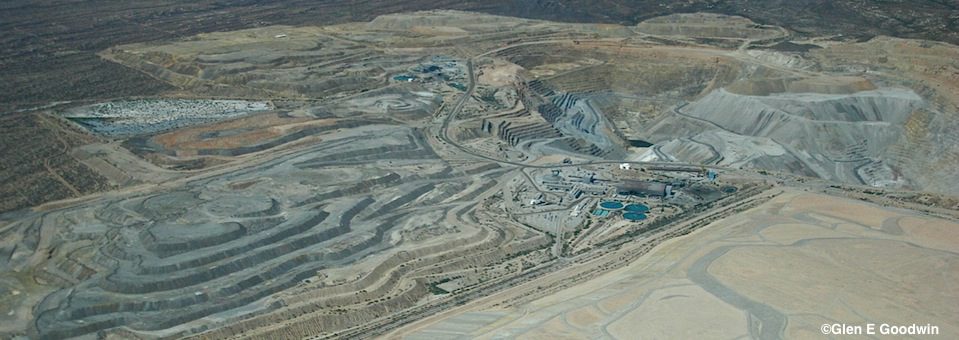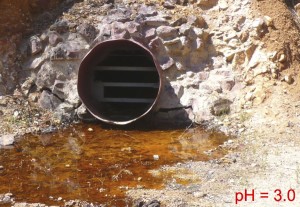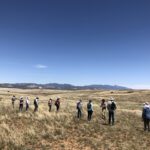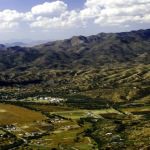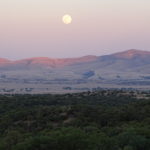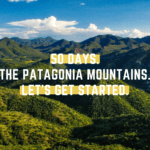This page was created as a single source site of mining impacts, both globally as well as historically in the Patagonia area. The reports are from government agencies, academic and non-government agency sources.
The Patagonia Area Resource Alliance recognizes that the health and economic prosperity of our community of Patagonia is tied deeply to the well-being of the Patagonia Mountains and Harshaw/Sonoita Creek waterways. They are the source of our water, clean air and the biological wealth drives our local economy.
PARA formed in 2011 to educate and engage the community about the risks and realities of mining, to promote local sustainable economies, to better understand our precious and imperiled natural resources such as clean water and wildlife, and to actively advocate for the protection of those resources along with Patagonia’s distinct and serene way of life.
Overview: 1872 Mining Law
The General Mining Law of 1872
The 1872 Mining Law is one of the last remaining dinosaurs of the old West. Signed by President Ulysses S. Grant over 130 years ago, this law still governs hardrock mining on federal public lands, even though other national policies and popular opinion have changed. 9/16/2011 By: Lauren Pagel, Alan Septoff of EARTHWORKS »Read more…
Potential Environmental Impacts of Hardrock Mining
The Hermosa Mine Proposal: Potential Impacts to Patagonia’s Water Supply
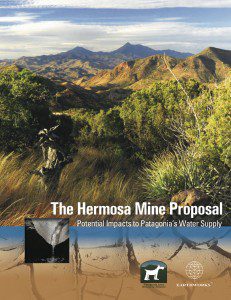 The 4,000-foot wide and 1,500-foot deep open-pit silver and manganese Hermosa mine proposed by AZ Mining Inc (Wildcat Silver) in southeastern Arizona, six miles from the town of Patagonia, threatens both the quantity and quality of area water supplies.
The 4,000-foot wide and 1,500-foot deep open-pit silver and manganese Hermosa mine proposed by AZ Mining Inc (Wildcat Silver) in southeastern Arizona, six miles from the town of Patagonia, threatens both the quantity and quality of area water supplies.
Using geologic and hydrologic studies from mine developer AZ Mining Inc (Wildcat Silver), the United States Geologic Survey, the Arizona Department of Water Resources, the town of Patagonia, and others, and by analyzing historic contamination issues caused by mining in the Patagonia Mountains, Potential Impacts explains how:
Patagonia is already facing a water supply crisis and new industrial water demands will make the problem worse.
The geology of the deposit virtually guarantees that the mine’s waste will cause acid drainage and metals leaching to contaminate water in perpetuity – an expensive and ever-lasting problem often paid for by taxpayers. The proposal will have numerous other impacts including a large carbon footprint, light pollution, noise pollution, and negative impacts to recreation, wildlife, habitat, and quality of life for area residents. Read The Hermosa Mine Proposal: Potential Impacts to Patagonia’s Water Supply Executive Summary here.
Mining Toxic Releases and Pollution
Environmental Protection Agency: 2011 Arizona Report
261 Arizona facilities reported a total of 98 million pounds of toxic chemical releases during 2011. Arizona’s total reported on-site and off-site releases increased 22% (18 million pounds), when compared to 2010 data. A TRI “release” is defined by the Federal reporting law as the amount of a toxic chemical released on-site (to air, water, underground injection, landfills, and other land disposal), and the amount transferred off-site for disposal; it is measured in pounds, unless stated otherwise.
Arizona mining companies account for 7 of the top 10 facilities with the largest chemical releases amounting to over 81.4 million pounds of toxic chemicals released out of the total amount of 98 million for all of Arizona in 2011 into the air, water and land.
Arizona mining companies account for 9 of the top 10 facilities in Arizona for total on-site and off-site releases of PBT chemicals. PBT stands for Persistent Bioaccumulative Toxic (PBT) chemicals. PBT chemicals are of particular concern not only because they are toxic, but also because they remain in the environment for long periods of time, are not readily destroyed, and build up or accumulate in body tissue. The TRI PBT chemicals include dioxin and dioxin-like compounds, lead and lead compounds, mercury and mercury compounds, polycyclic aromatic compounds (PACs), poly-chlorinated biphenyls (PCBs), and certain pesticides, among other chemicals. Arizona mining companies released 15.8 million pounds of PBT chemicals out of the total amount of 16 million for all of Arizona in 2011. Read 2011 Arizona Toxic Inventory Summary here.
The EPA released the 2012 Arizona Report in February 2014
A new feature of the EPA TRI Program allows for searching zip codes and counties.
Santa Cruz County currently has ZERO reported toxic chemical releases for 2012 and no mines.
Pima County, on the other hand, has over 5.8 million pounds of toxic chemical releases for 2012.
The two mines operating in Pima County are the biggest polluters, accounting for over 5.6 million pounds of toxic chemical releases.
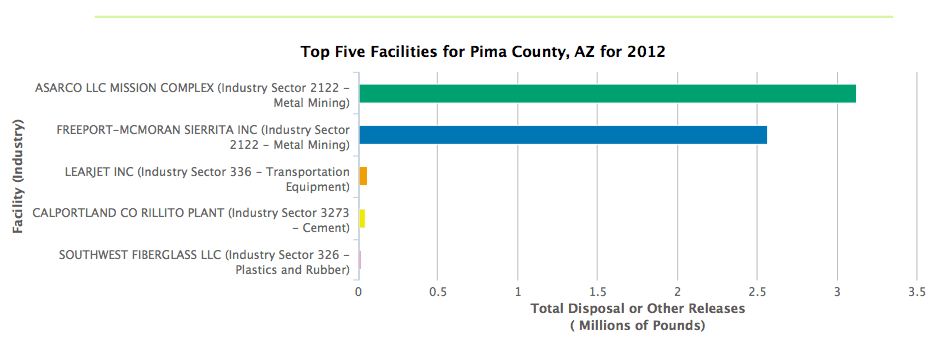
Potential Water Impacts
Water Quality
How mining companies are polluting our nation’s waters in perpetuity
In the midst of declining fresh water supplies, an increasing number of hard rock mining companies are generating water pollution that will last for hundreds or thousands of years and new projects are on the horizon. Perpetual management of mines is a rapidly escalating national dilemma. Our research shows, for the first time, the staggering amount of our nation’s water supplies that are perpetually polluted by mining. 5/1/2013 By: Bonnie Gestring, Lisa Sumi of EARTHWORKS »Read more…
Acid Mine Drainage
Acid mine drainage (AMD) refers to the outflow of acidic water from a mining site. In most cases, this acid comes primarily from oxidation of iron sulfide (FeS2, also known as pyrite or “fool’s gold”), which is often found in conjunction with valuable metals. Acid mine drainage is a major problem with many hardrock mines, including almost all mines where the metal ore is bound up with sulfur. 1/18/2013 By: David Coil, PhD, Erin McKittrick, M.S., Andrew Mattox, Niki Hoagland, Bretwood “Hig” Higman, PhD, Kendra Zamzow of Ground Truth Trekking »Read more…
U.S. COPPER PORPHYRY MINES: The track record of water quality impacts resulting from pipeline spills, tailings failures and water collection and treatment failures.
Our research shows that copper porphyry mines are often associated with water pollution associated with acid mine drainage, metals leaching and/or accidental releases of toxic materials. We found that all of the mines experienced at least one failure, with most mines experiencing multiple failures. July 2012 By: Bonnie Gestring of EARTHWORKS »Read more…
Local Water Quality Issues from Historic Mining
Total Maximum Daily Load For: Upper Harshaw Creek, Sonoita Creek Basin, Santa Cruz River Watershed, Coronado National Forest, near Patagonia, Santa Cruz County, Arizona
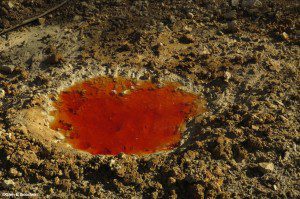
Water seepage from abandoned mine in Patagonia Mountains with a highly acidic pH of 2.0.
ADEQ performed this investigation of upper Harshaw Creek in response to the stream being listed for violations of water quality standards on the 1996 and 1998 303[d] Lists. Because Harshaw Creek is one of three stream segments in the Sonoita Basin that was listed on the State’s 303[d] List of impaired waters, ADEQ decided to perform investigations of these segments simultaneously. The other waterbodies in this study are Alum Gulch and Three R Canyon. This project was started in 1997 and site monitoring was performed between 1997 and 2000 by ADEQ staff. 6/30/2003 By: Robert Scalamera, Hydrologist, TMDL Unit of Arizona Department of Environmental Quality »Read more…
Total Maximum Daily Load For: Upper Alum Gulch, Sonoita Creek Basin, Santa Cruz River Watershed, Coronado National Forest near Patagonia, Santa Cruz County, Arizona. Parameters: Cadmium, Copper, Zinc, and Acidity
ADEQ performed this investigation of upper Alum Gulch in response to the stream being listed for violations of water quality standards on the 1996 and 1998 303[d] Lists. Because Alum Gulch is one of three stream segments in the Sonoita Basin that was listed on the State’s 303[d] List of impaired waters, ADEQ decided to perform investigations of these segments simultaneously. The other waterbodies in this study are Harshaw Creek and Three R Canyon. This project was started in 1997 and site monitoring was performed between 1997 and 2000 by ADEQ staff. 6/30/2003 By: Robert Scalamera, Hydrologist, TMDL Unit of Arizona Department of Environmental Quality »Read more…
TMDL IMPLEMENTATION PLAN For Cadmium, Copper, Zinc and Acidity in ALUM GULCH
The purpose of the Alum Gulch TMDL Implementation Plan is to provide an action plan for the implementation of removal and remediation actions designed to achieve the pollutant load reductions identified in the Alum Gulch TMDL for cadmium, copper, zinc and acidity. This implementation plan is a dynamic document that supports revision and improvements of implementation actions based on applied lessons learned. Plan revisions will be administered by ADEQ staff with stakeholder involvement and contribution. March 2007 By: Arizona Department of Environmental Quality » Read more…
Water Quality Division: Monitoring and Assessment: Total Maximum Daily Load (TMDL) Program
The Total Maximum Daily Load (TMDL) Program is designed to help an impaired stream or lake meet its water quality standards and support its designated uses, such as protection of aquatic life, drinking water, and fish consumption. Section 303(d) of the Clean Water Act established authority for the TMDL Program and guides states on how to develop these plans for waters that do not meet water quality standards. Arizona Department of Environmental Quality website »Read more…
Hydraulic Adit Plug Closure: World’s Fair Mine, Patagonia, Arizona
World’s Fair Mine Adit – Flow and Water Quality: 1) Flow typically 3-5 gallons per minute, maximum 18 gpm; 2) Acidic pH 2.9 – 3.7; 3) Geochemically degraded waters with respect to Cadmium, Copper, Iron, Lead, Manganese, Nickel, and Zinc; 4) Significant source of loading to Alum Gulch. May 2011, by Allan Kirk, Matt Wetter, Nathan Stormz and Eli Curiel, USFS Coronado National Forest and Tetra tech »Read more…
Water Quantity
Town Manager Advises Water Alert
Patagonia’s well water levels are at an all-time low and have been so for the past three months. Town Manager David Teel has recommended that the town declare a water alert and will begin discussion with the town council during the next few weeks as to when and how to begin implementing water use restrictions.
Pumping data for Patagonia’s wells over the past six years indicates that the depth to which the pumps must go to access water has gone from an average of 21.7 feet in 2008 to an average of 39.4 feet in 2013. Teel says that, although water consumption can affect well pumping levels, the town’s water use last year was only about 10% above the average for the past six years, and the sustained drought that is occurring statewide is considered to be the primary cause for the lower water level. Arizona has been experiencing drought conditions for nearly 15 years, which, according to The National Drought Mitigation Center, is the longest recorded period of drought in 110 years. 2/9/2014 By: Donna Reibslager, Patagonia Regional Times »Read more…
AN INVESTIGATION OF ENERGY USE, WATER SUPPLY AND WASTEWATER TREATMENT AT PATAGONIA, ARIZONA
The City of Patagonia relies solely upon groundwater to serve its residents. Two wells, operated alternately and equipped with submersible pumps, are located within the center of town and supply water directly into the distribution system and to an upper storage reservoir. The static water levels of the wells vary from 15 to 30 feet below the land surface, depending on demand and time of year. 2009 By: Brian Billy, Dr. Muniram Budhu, and Dr. Robert Casavant »Read more…
2012 Water Year in Review
The 2012 Water Year in Review is a summary of the information presented in the Southwest Climate Outlook between October 1, 2011, and September 30, 2012. The water year is a standard period of measurement used in hydrology because the natural seasonal ground recharge and discharge cycles are more aligned with the October–September period than the calendar year due to precipitation and evaporation patterns. This review highlights precipitation, temperature, reservoir levels, drought, wildfire, and El Niño-Southern Oscillation (ENSO) conditions over this 12-month period.
Warmer-than-average temperatures and below-average precipitation across nearly all of Arizona and New Mexico characterized the water year. Consequently, moderate or more severe drought covers almost the entire Southwest and drought conditions are now more widespread, though less intense, than they were at the beginning of the water year. The fact that drought has persisted in many parts of the Southwest during the last two years is not surprising given the occurrence of a La Niña event during back-to-back winters; La Niña conditions often deflect winter storms north of the Southwest. It was also a relatively dry winter in the headwaters of the Colorado River and Rio Grande in Colorado, where scant rain and snow contributed to storage declines in many reservoirs on these rivers. Dry conditions also set the stage for wildland fires in the Southwest. October 2012 By: Southwest Climate Outlook, University of Arizona »Read more…
Air Impacts
Mine Tailing Waste in Arid and Semi-Arid Environments: A Particulate Matter Requiring Stakeholder Cooperation
Mine tailings are large piles of crushed rock that are left over after the metals of interest like lead, zinc, copper, silver, gold and others, have been extracted from the mineral rocks that contained them. The mineral separation process in older mining or legacy operations was only partially efficient. As a result, after the crushing and grinding processes, some of the metal-containing minerals were left behind associated with tailings particles. Spread of metal toxicants in association with tailings particles, through a combination of wind dispersion and water erosion, has been shown to result in measurable elevated levels in wildlife and humans even significant distances from the tailings site1,3. In contrast, modern tailings generally have low metal content due to improved extraction processes but the size of the tailings particles is, on average, smaller. These small size particles form aerosols more easily and even though they are not associated with metals, these small particulates may impact human health especially in those with pre-existing respiratory conditions. November 2011, By: Mónica Ramírez-Andreotta, Heather Henry, John Hillenbrand, Raina M. Maier, Diana Meza Figueroa, and David J. Williams Superfund Research Program, The University of Arizona »Read more…
Other Potential Impacts of Hardrock Mining
Agricultural Impacts
UNDER-MINING AGRICULTURE: How the Extractive Industries Threaten our Food Systems
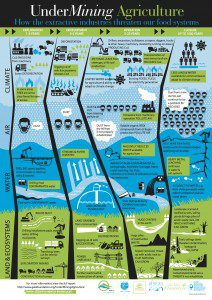 UnderMining Agriculture alerts us to the impact that the extractive industries are having on our capacity to feed ourselves and the health of our planet’s ecosystems. UnderMining Agriculture looks at the real impact of mining – from prospecting and operations through to closure – on agriculture, food production, soil fertility, fresh water systems, the air that we breathe, and our already challenged climate. Without healthy ecosystems there can be no healthy food. Without water there can be no life.
UnderMining Agriculture alerts us to the impact that the extractive industries are having on our capacity to feed ourselves and the health of our planet’s ecosystems. UnderMining Agriculture looks at the real impact of mining – from prospecting and operations through to closure – on agriculture, food production, soil fertility, fresh water systems, the air that we breathe, and our already challenged climate. Without healthy ecosystems there can be no healthy food. Without water there can be no life.
The extraction of minerals, metals and fossil fuels, pollutes areas far wider than the actual mining sites and for many years after the closure of operations. Meanwhile, governments promote mining and provide incentives, arguing that it is in the “national interest“ and “contributes to economic growth”, with little evidence of either. In fact evidence shows that most profits go to the mining company, and little remains in the source country; jobs promised are always less in reality and few go to locals; and the host country not only gives incentives, but tends to bear many associated costs, such as infrastructure to serve the mine, not to mention dealing with the impacts to ecosystems and communities when the mine closes. There is also scant recognition of the true costs to the conditions of life for present and future generations of all species, including our own. September 2014 By: The Gaia Foundation »Read more…
BIOACCUMULATION OF HEAVY METALS FROM SOILS TO PLANTS IN WATERSHEDS CONTAMINATED BY ACID MINE DRAINAGE IN SE ARIZONA
Current concerns about inorganic contaminants in food products have raised consumer awareness of anthropogenic sources of heavy metal contamination in ecosystems and their potential threat to human health. Mining and exploration of mineralized zones is a major source of such contamination. Mining throughout the Patagonia Mountains, Arizona, has left a legacy of surface water contamination by acid mine drainage (AMD).
This study assessed the impacts of AMD on soils and plants throughout the study area. Concentrations, transport, and loading of heavy metals (silver, arsenic, cadmium, cobalt, chromium, copper, iron, manganese, molybdenum, nickel, lead, antimony, and zinc) in soils and plants was quantified using total concentrations, suggested toxic levels, and plant and soil pollution indices. Pollution indices were modified to include antimony and molybdenum. Pollution indices greater than 100 were found in areas disturbed by mining, remediation sites and beyond. Cattle grazing on grasses contaminated by metals were documented.
As concerns about the quality of food supplies continue to mount, monitoring the conditions under which food is grown should also be increased. The practice of dumping mine waste in streambeds creates pollution levels that take ecosystems decades or centuries to recover from. As cattle continue to graze in these mountains, and wildlife continues to depend on the ecosystems created by the Sonoita Creek drainage basin, the need for additional research and continued monitoring of this area is essential.
2012 By: Katherine Eddleman, University of Arizona »Read more…
SocioEconomic Impacts
The Failure of the Rosemont Mine DEIS to Adequately Analyze the Socioeconomic Impacts of the Proposed Mine
In early December of 2011, two local business owners surveyed the owners of all identified small businesses in the area surrounding the towns of Sonoita, Elgin, and Patagonia to the south of the proposed Rosemont Mine in Santa Cruz County.[38] They identified 217 businesses employing approximately 800 people. The survey asked two questions: What percentage of the firm’s sales was derived from visitors to the area? What percentage of those visitors were drawn to the area by its landscape and cultural amenities*? The responses indicated that about 66 percent of these firms’ sales were tied to the purchases of visitors rather than residents. In addition, 78 percent of the visitors were drawn to the area by the landscape and cultural amenities as opposed to just passing through, being on business, visiting family, etc. Combined, these results indicate that the landscape and cultural amenities were responsible for 51 percent of local business sales in the area. If employment is proportional to sales, this would suggest that 386 local jobs are associated with the surrounding landscape and cultural amenities in this small town and rural area.” *These “amenities” were defined on the survey as hiking, biking, birding, hunting, equestrian activities, ranches, relaxation get-aways, health and wellness, historic and cultural sites, arts and artists, dining, and shopping. January 2012 By: Thomas Michael Power, PhD, Donovan S. Power, MS, Power Consulting for Mountain Empire Action Alliance »Read more…
ARIZONA TRAVEL IMPACTS: 1998-2014P
2015 Arizona Travel Impact Summary: $20.9 billion in direct spending 2014 by Arizona visitors generated 171,500 direct jobs, This represents an addition of 6,200 jobs, an increase of 3.8 percent. Jobs were added in all major sectors of the travel industry. Additionally, tourism generated over $2.7 billion in local, state and federal tax revenues.
Tourism to Tucson and Southern Arizona resulted in over $3.6 billion in direct spending that generated over 30,000 direct jobs, $785 million direct earnings, and $245 million in local and state tax revenues. 6/2015 By: Dean Runyan Associates for the Arizona Office of Tourism »Read more…
Valuing Our Western Public Lands: Safeguarding Our Economy and Way of Life
In this report, the National Wildlife Federation explores the “value” of America’s public lands. As a noun, “value” refers to monetary worth. As a verb, “value” refers to the act of appreciating and treasuring something. This report compiles and summarizes data from a growing body of research on the value of public lands, which confirms that public lands are vital to the nation’s economic health and deeply valued by the American public. Public lands support a booming tourism and outdoor industry. The outdoor recreation industry alone contributes nearly $650 billion to the U.S. economy and supports over 6 million jobs. Published: 2013 by National Wildlife Federation »Read more…
Birding in the United States: A Demographic and Economic Analysis
Birders spend money on a variety of goods and services for their trip-related and equipment-related purchases. Trip-related expenditures include food, lodging, transportation, and other incidental expenses. Equipment expenditures consist of binoculars, cameras, camping equipment, and other costs. By having ripple effects throughout the economy, these direct expenditures are only part of the economic impact of birding.
This report presented information on the participation and expenditure patterns of 47 million birders in 2011. Trip-related and equipment-related expenditures associated with birding generated nearly $107 billion in total industry output, 666,000 jobs, and $13 billion in local, state, and federal tax revenue. This impact was distributed across local, state, and national economies.
Published: December 2013 by Erin Carver, U.S. Fish and Wildlife Service Division of Economics»Read more…
Biodiversity Impacts
Patagonia BioBlitz: Madrean Archipelago Biodiversity Assessment
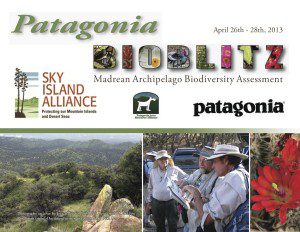 The weekend of April 26th through 28th marked an exciting event for the community of Patagonia, Arizona. Biologists from all over the state gathered to document and celebrate the tremendous biodiversity of the Patagonia Mountains, one of the southernmost Sky Island ranges in the United States, and an area threatened by four proposed mining operations. A bioblitz is a relatively recent term describing a short but intense period of biological surveying, meant to identify as many species as possible for a designated area, while also involving the public and raising awareness about the importance of conservation. May 2013 By: Nick Deyo, Sky Island Alliance »Read more…
The weekend of April 26th through 28th marked an exciting event for the community of Patagonia, Arizona. Biologists from all over the state gathered to document and celebrate the tremendous biodiversity of the Patagonia Mountains, one of the southernmost Sky Island ranges in the United States, and an area threatened by four proposed mining operations. A bioblitz is a relatively recent term describing a short but intense period of biological surveying, meant to identify as many species as possible for a designated area, while also involving the public and raising awareness about the importance of conservation. May 2013 By: Nick Deyo, Sky Island Alliance »Read more…
Arizona Missing Linkages: Patagonia – Santa Rita Linkage Design
Nature Needs Room to Move: Movement is essential to wildlife survival, whether it be the day-to-day movements of individuals seeking food, shelter, or mates, dispersal of offspring (e.g., seeds, pollen, fledglings) to new home areas, gene flow, migration to avoid seasonally unfavorable conditions, recolonization of unoccupied habitat after environmental disturbances, or shifting of a species’ geographic range in response to global climate change.
Habitat fragmentation is a major reason for regional declines in native species. Species that once moved freely through a mosaic of natural vegetation types are now being confronted with a human-made labyrinth of barriers such as roads, homes, and agricultural fields. Movement patterns crucial to species survival are being permanently altered at unprecedented rates. Countering this threat requires a systematic approach for identifying, protecting, and restoring functional connections across the landscape to allow essential ecological processes to continue operating as they have for millennia.
Ecological Significance of the Santa Rita-Patagonia Wildland Blocks and Linkage Area: The Santa Rita and Patagonia linkage planning area lies within Sky Island Ecoregion of southeastern Arizona and southwestern New Mexico. The Sky Islands are a complex of relatively small, isolated mountain ranges surrounded by lower elevation areas of desert scrub and grasslands that provide unique geological and topographic environments. These features make it one of the most biologically diverse landscapes in North America. The Coronado National Forest, which manages most of the sky island mountain ranges in Arizona, harbors the greatest plant and animal diversity of any National Forest in the United States, totaling more than 2000 plant species and 576 species of terrestrial vertebrates, including 78 mammals, over 400 birds, and over 60 reptiles. Of these species, 175 are considered threatened, endangered or sensitive. By: Beier, P., E. Garding, and D. Majka. 2008. Report to Arizona Game and Fish Department. School of Forestry, Northern Arizona University. »Read more…
BIODIVERSITY IN IMPACT ASSESSMENT
Biodiversity matters to everyone. Its loss impoverishes the environment and reduces its capacity to support people now and in the future. Impact assessment can help to ensure development is compatible with the conservation and sustainable use of biodiversity.
Biodiversity: The Basis of Our Existence The first World Summit on Environment and Development in Rio de Janeiro (1992) emphasized the importance of biodiversity as the basis of our very existence, to be used wisely and sustainably and conserved for current and future generations. The main threats to global biodiversity are associated with human activities causing habitat loss or damage. July 2005 By: INTERNATIONAL ASSOCIATION for IMPACT ASSESSMENT »Read more…
Opinion of Academic Community
The Other Patagonia
I’m struck by the biological diversity here: sky islands, washes, desert flats, and grasslands that attract wildlife of all kinds. In a nearby protected habitat, the Patagonia-Sonoita Creek Preserve, biologists have documented more than 300 species of birds, including violet-crowned hummingbirds and black-bellied whistling ducks. June 2013 By: Elizabeth Bernays, Regents’ Professor, University of Arizona for Natural History Magazine »Read more…
Academic Community Opinion: Protect a Unique Environment in Southeast Arizona
The Problem of Proposed Open Pit Mines in Santa Rita Mountains and Patagonia Mountains in Southeast Arizona: Due to planned mines, southeast Arizona is threatened as a habitat for both wildlife and people. The biological diversity is higher than for any region in the USA, with its sky islands, washes, desert flats and grasslands creating a major tourism industry based on naturalists, hunters, hikers, bikers, and researchers. The Nature Conservancy’s Patagonia-Sonoita Creek Preserve is quoted by the Audubon Society as the one of the best birding locations in the entire country. Link to document with the names of hundreds of academic signatories attesting to the concern of many who care about our environment, our state, and our country. Document compiled and signatures obtained by Elizabeth Bernays, Regents’ Professor Emeritus, University of Arizona from February to July 2012.
Appendix B: Potential Environmental Impacts of Hardrock Mining
This appendix describes potential environmental effects of hardrock mining. EPA recognizes that some of the discussion in this appendix may not accurately reflect the environmental conditions at modern hardrock mining operations that are well designed, well operated, and well regulated. The intent of the discussion is to highlight environmental problems at (predominantly historic) mining sites and to suggest that these are potential problems that could occur at existing and future sites. In addition, there is some repetition in the following sections resulting from the inter-related nature of impacts (for example, the fact that erosion and sedimentation are relevant both to water quality and aquatic ecosystem quality). Sections describe several of the major impacts of mining operations. Sections include: Surface Water Quality Issues, Ground water Quality, Hydrologic Impacts, Physical Stability, Air Quality, Soils and Terrestrial and Aquatic Habitat/Ecosystem Quality. September 1997, Hardrock Mining Framework, United States Environmental Protection Agency »Read more…
Chapter One:Overview of Mining and its Impacts
Proposed mining projects vary according to the type of metals or materials to be extracted from the earth. The majority of proposed mining projects involve the extraction of ore deposits such as copper, nickel, cobalt, gold, silver, lead, zinc, molybdenum, and platinum. The environmental impacts of large-scale mining projects involving these metal ores are the subject of this Guidebook. 2010, Guidebook for Evaluating Mining Project EIAs, Environmental Law Alliance Worldwide »Read more…
